Ingredient GuidesPantry PowerTipsCanned tomatoes
Everything you want to know about canned tomatoes! We'll tell you about the different kinds, what swaps you can make, and how to make the most of whatever kind of canned tomato you have!
Print 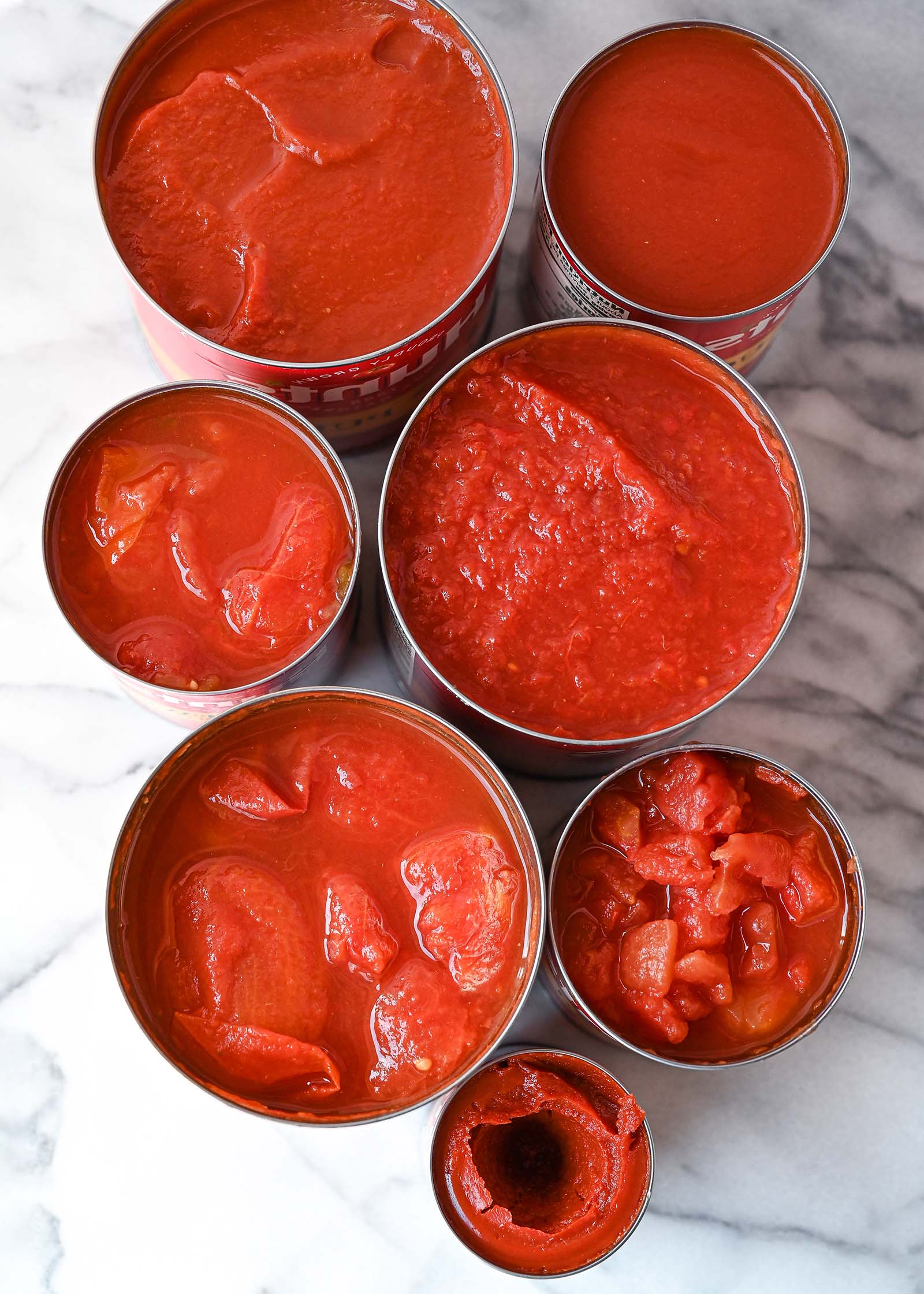
We are cooking from the pantry now more than ever, which means we’re trying to keep it stocked with staples. And canned tomatoes? Definitely a staple! So many recipes – chili, meatballs, Indian butter chicken, Mexican lasagna – call for a can of tomatoes.
But what kind of can? Depending on the recipe, you may be asked for diced tomatoes, crushed, whole peeled … the list goes on! So what’s the difference between all these different types of canned tomatoes? And can you swap, say, a can of crushed tomatoes with a can of diced tomatoes? Or maybe the shelves at your grocery store are cleared out of every kind of canned tomato but the stewed variety. You’ve never bought stewed tomatoes before. What are stewed tomatoes?!
We have answers, friends, and can help light the way on your canned tomato journey!
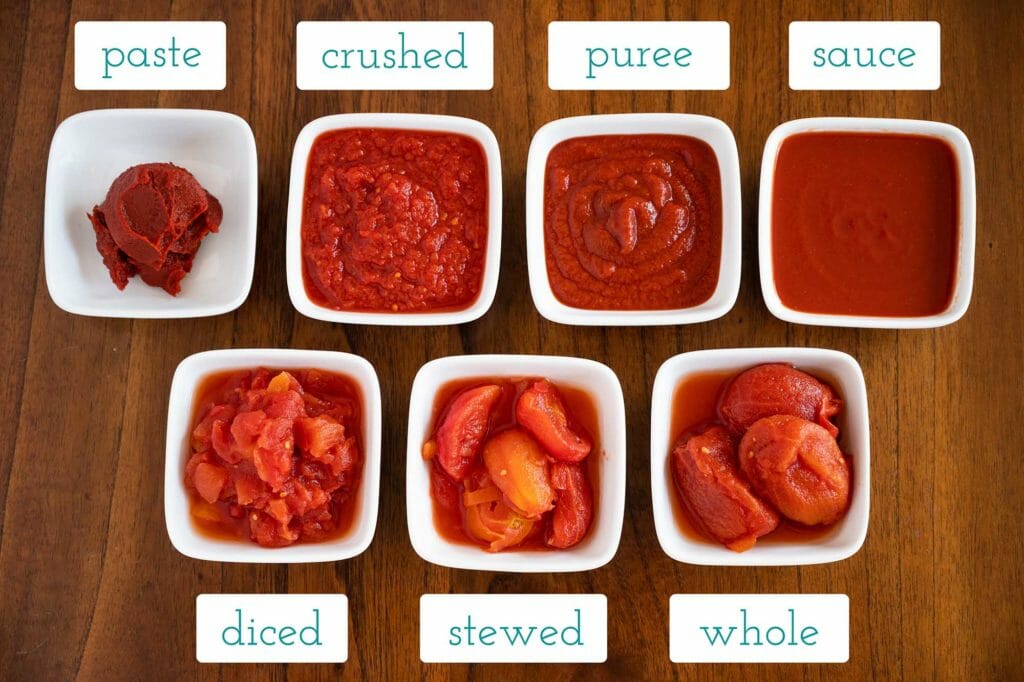
What’s In a Can of Tomatoes?
Every kind of canned tomato starts the same way: with freshly-picked tomatoes (usually plum tomatoes) that are peeled, cooked, and processed shortly after they’re harvested in order to retain that ripe, red flavor they have at their peak.
For peeling, the tomatoes are either placed in a lye bath, which is cheap and efficient, or steam-peeled. Many brands state “steam peeled” on the label if that’s how they’ve been processed. All organic peeled tomatoes must be steam-peeled in order to be labeled organic.
Depending on the type of canned tomato and the brand, ingredient lists on a can of tomatoes can range from short and sweet (“tomatoes, tomato juice”) to slightly longer if the tomatoes were processed with citric acid, calcium chloride, or include flavorings like basil and garlic. Diced tomatoes, for example, always include calcium chloride because it helps the tomato pieces keep their shape.

Whole peeled tomatoes
WHOLE PEELED TOMATOES
Whole peeled tomatoes are packed in either tomato juice or puree. They are the most versatile kind of canned tomato you can buy, since you can basically turn a whole peeled tomato into whatever you need! On their own they’re great for long-simmering recipes like homemade tomato sauce, tomato soup, or chicken stew where you want the tomatoes to really break down.
SWAP TIP: Turn whole peeled tomatoes into what you need! Chop them into diced tomatoes, press them through a food mill, with a potato masher (or use your hands) to make crushed tomatoes, or blend them in a food processor or blender for a purée.
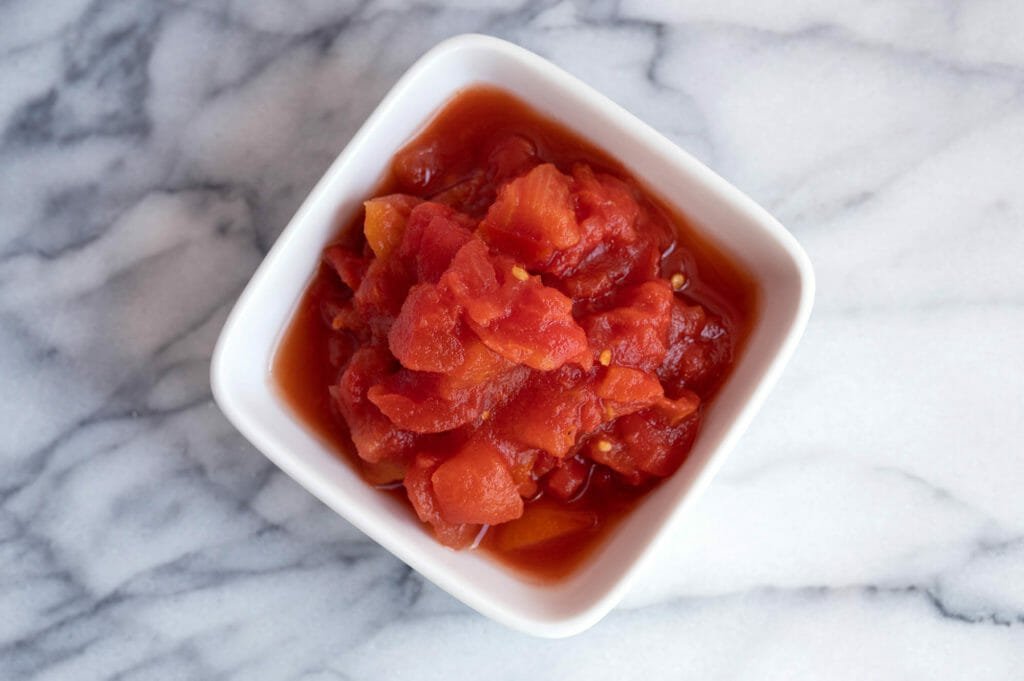
Diced tomatoes
DICED TOMATOES
Diced tomatoes are chopped prior to canning and then processed with calcium chloride and citric acid to help the pieces keep their shape. As a result, they’re firmer than either whole or crushed tomatoes, so even though you’d expect the smaller pieces to break down quicker in cooking, the opposite actually happens!
Diced tomatoes work best in recipes where you want visible, tastable tomato chunks after cooking, like in beef chili or taco soup (particularly if you pick up a fire-roasted variety!), fish stew, chickpea curry, or baked shrimp in feta sauce!
SWAP TIP: Diced tomatoes can be used in place of whole or crushed tomatoes, but be aware you may need to increase the cooking time to try and break down the tomatoes—even then they probably won’t break down entirely. You can also puree them in a food processor or blender if you like.
Diced tomatoes should not be used to make homemade tomato sauce.
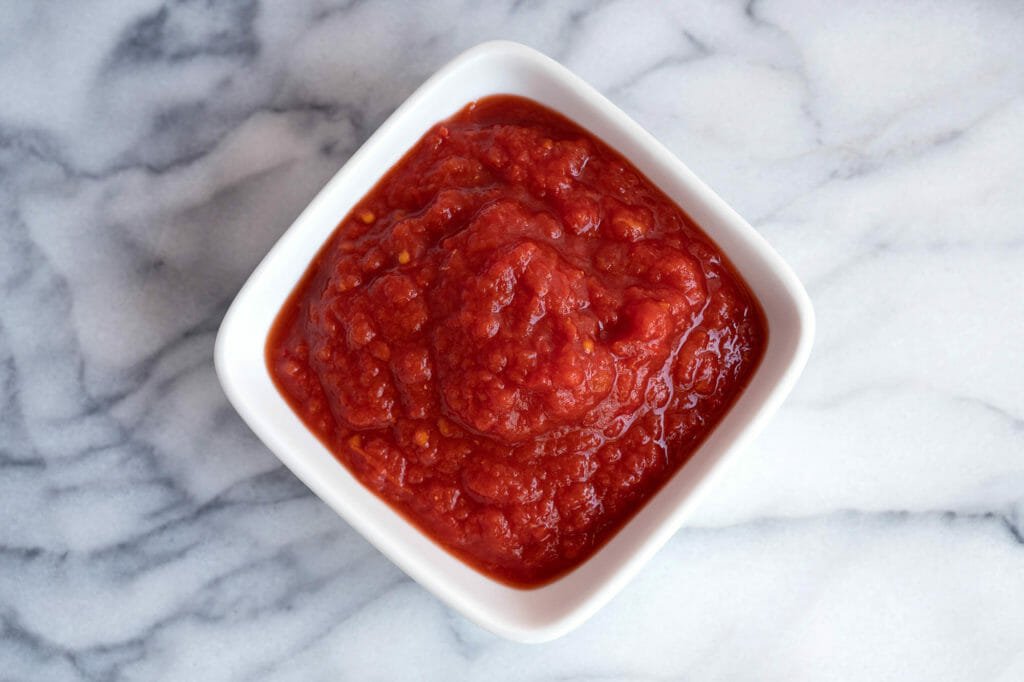
Crushed tomatoes
CRUSHED TOMATOES
Crushed tomatoes are usually mixed with tomato puree or tomato juice, which makes them saucier than diced tomatoes, yet still chunkier than full-on tomato sauce. They’re also one step more convenient than whole peeled tomatoes when making a recipe like chicken parmesan, chicken marinara, lasagna or a simmered soup like minestrone.
SWAP TIP: Crushed tomatoes can be used in place of whole peeled tomatoes or puréed tomatoes in recipes where the tomatoes are meant to break down into a sauce or soup.
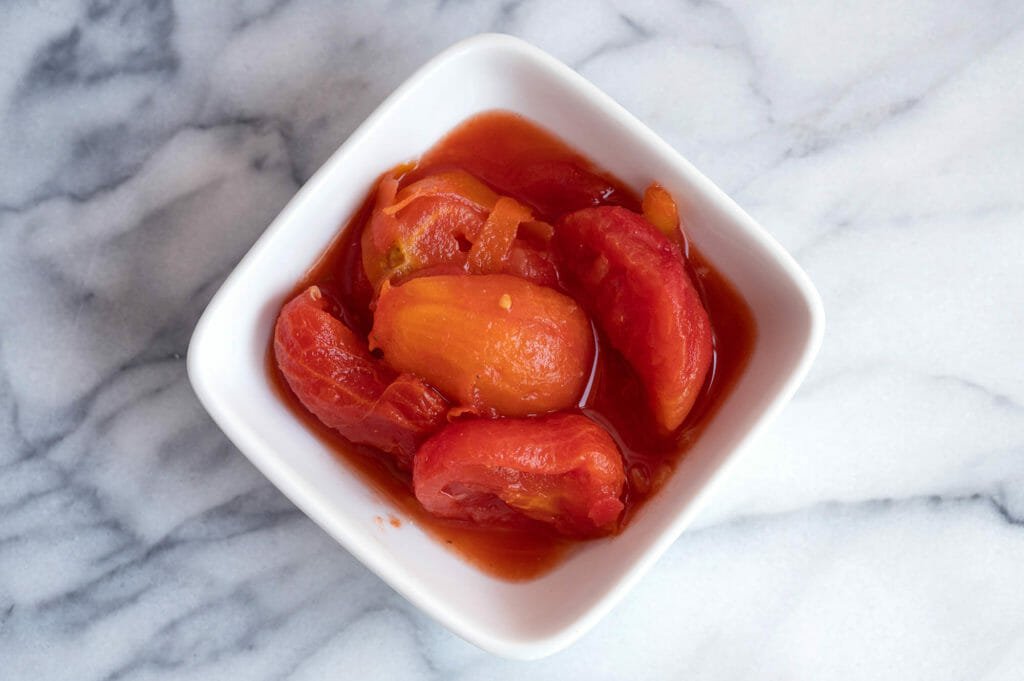
Stewed tomatoes
STEWED TOMATOES
Stewed tomatoes have been cooked and seasoned with sugar, herbs, spices, and other flavorings like celery, onions, and peppers prior to being canned. They’re typically softer and sweeter than whole, crushed, or diced canned tomatoes.
Because the flavor varies widely depending on the added ingredients, it’s not terribly common to see a recipe calling for canned stewed tomatoes, or if it does, it probably specifies a specific brand so that the flavor is consistent.
SWAP TIP: Stewed tomatoes can be swapped for whole, crushed, or diced tomatoes if and only if the additional ingredients would mesh with the recipe you’re making. You’ll have to do a little flavor sleuthing and deciphering!

Pureéd tomatoes
PUREED TOMATOES
Puréed tomatoes have been seeded and strained into a thick and smooth purée that is most similar in texture to crushed tomatoes, just a bit thicker. They can be a handy shortcut for recipes like tomato soup or sauces like tomato sauce or enchilada sauce, but don’t let the fact that the tomatoes are already broken down cut your cooking time too much! A long simmer is still needed to really reduce and concentrate flavor in those recipes, especially if the tomato purée was a little watery to begin with.
SWAP TIP: Puréed tomatoes can be used in place of whole peeled tomatoes or crushed tomatoes in recipes where a smooth sauce is the end goal.

Tomato sauce
TOMATO SAUCE
Tomato sauce has been cooked and blended into a very smooth sauce with a concentrated tomato flavor (more than tomato purée, less than tomato paste). It is sometimes made by adding water to tomato paste.
Do not confuse canned tomato sauce with jarred pasta sauce or homemade tomato sauce! They are not the same thing at all. Canned tomato sauce has not been flavored with seasonings, salt, or oil, but it makes a great base for homemade pizza sauce, barbecue sauce, dipping sauce, mushroom sauce or a sweet, saucy dish like baked beans!
SWAP TIP: With some additional seasoning and cooking, canned tomato sauce can be used in place of jarred pasta or pizza sauce or in stews, braises, or casseroles where a strong, sweet tomato flavor is desired.
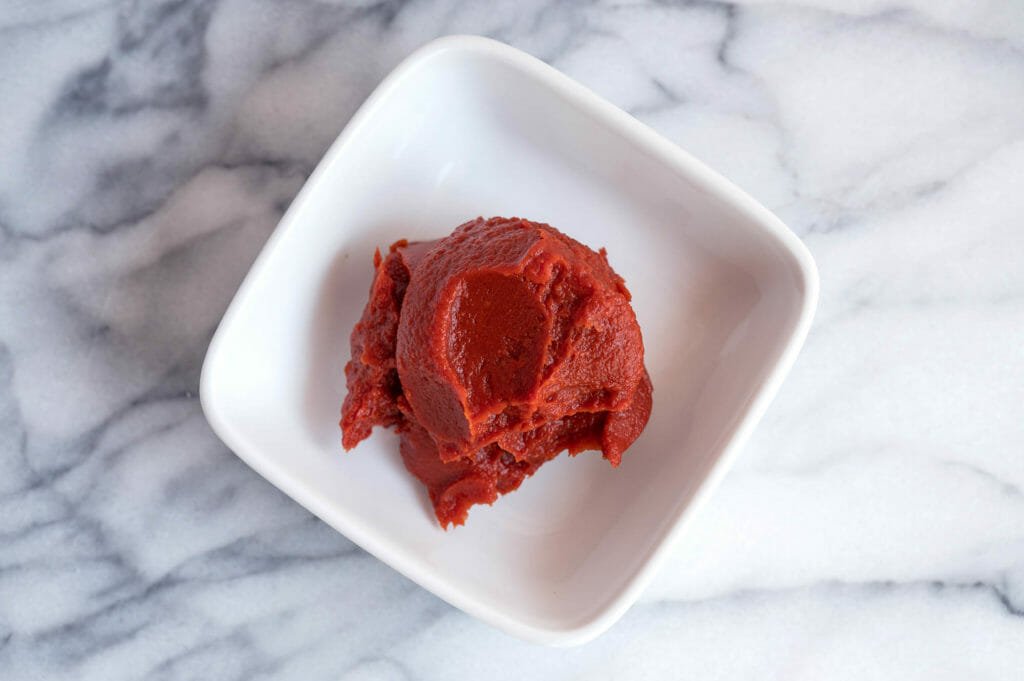
Tomato paste
TOMATO PASTE
Tomato paste is made by cooking down the tomatoes until all the juice has evaporated and the tomatoes have developed a dark red color and concentrated flavor. You’ll find tomato paste in all sorts of recipes, like vegetable lentil soup, where it’s often added right after cooking the chopped onions, garlic, celery, or carrots to caramelize in the oil and add a wonderful savory note and a bit of thickening. It’s incredibly versatile and a staple for sure!
SWAP TIP: Tomato paste can be thinned with water and used in place of tomato sauce.
Follow me on Pinterest
This post may contain links to Amazon or other partners; your purchases via these links can benefit Simply Recipes. Read more about our affiliate linking policy.
 Cambria Bold
Cambria Bold
Cambria Bold is the Product and Lifestyle Director for Simply Recipes. She has almost a decade's worth of online editorial experience and know-how, first as the Managing Editor for Apartment Therapy's green living site Re-Nest (RIP) and later as the Design and Lifestyle Editor for The Kitchn. She lives in St. Paul, Minnesota with her husband and their two little girls.
More from Cambria





